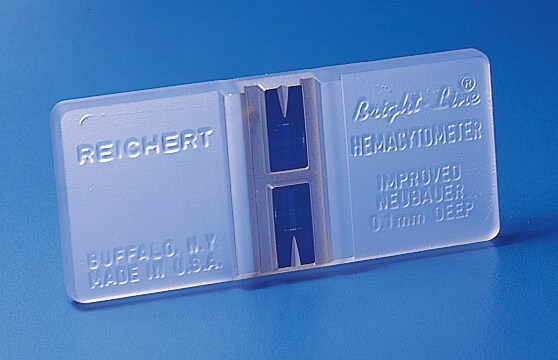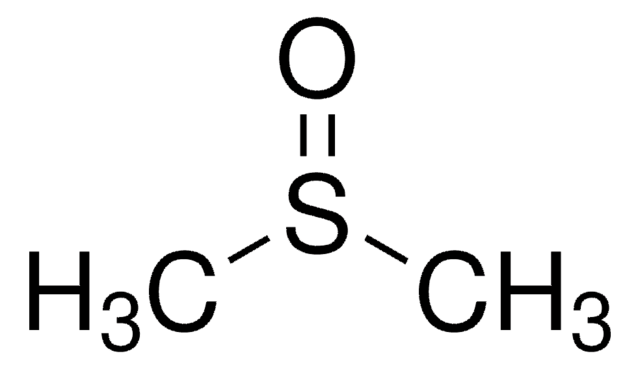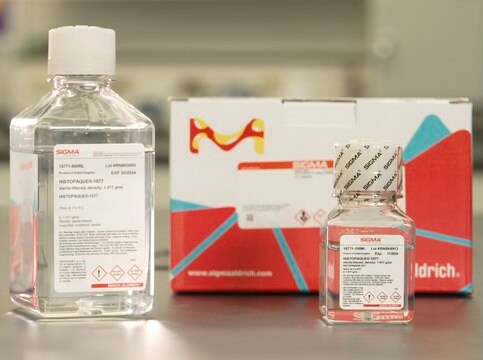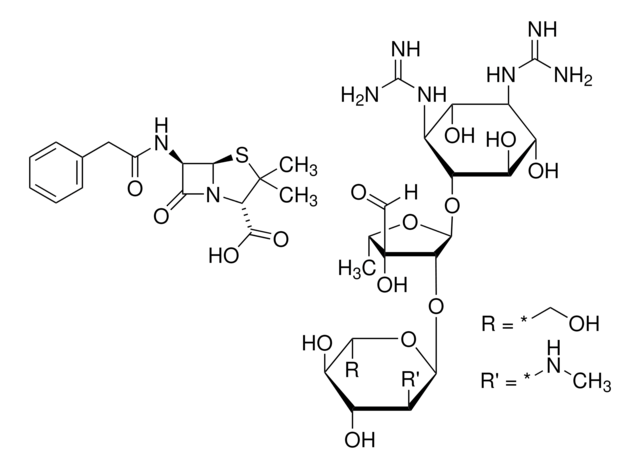T8154
Trypan Blue solution
0.4%, liquid, sterile-filtered, suitable for cell culture
Recommended Products
sterility
sterile-filtered
Quality Level
form
liquid
storage condition
dry at room temperature
concentration
0.4%
technique(s)
cell culture | mammalian: suitable
tissue processing: suitable
application(s)
cell analysis
shipped in
ambient
SMILES string
[Na+].[Na+].[Na+].[Na+].Cc1cc(ccc1N=Nc2c(O)c3c(N)cc(cc3cc2S([O-])(=O)=O)S([O-])(=O)=O)-c4ccc(N=Nc5c(O)c6c(N)cc(cc6cc5S([O-])(=O)=O)S([O-])(=O)=O)c(C)c4
InChI
1S/C34H28N6O14S4.4Na/c1-15-7-17(3-5-25(15)37-39-31-27(57(49,50)51)11-19-9-21(55(43,44)45)13-23(35)29(19)33(31)41)18-4-6-26(16(2)8-18)38-40-32-28(58(52,53)54)12-20-10-22(56(46,47)48)14-24(36)30(20)34(32)42;;;;/h3-14,41-42H,35-36H2,1-2H3,(H,43,44,45)(H,46,47,48)(H,49,50,51)(H,52,53,54);;;;/q;4*+1/p-4
InChI key
GLNADSQYFUSGOU-UHFFFAOYSA-J
Looking for similar products? Visit Product Comparison Guide
General description
Application
- in cell viability assay to count viable and dead cells
- in rescue assay to count viable cells
- in trypan blue exclusion counting method to determine proliferation curve
- as the saline control and in the preparation of lipopolysaccharide (LPS) solution to confirm the success of LPS infusion
- in trypan blue dye exclusion test to determine gastric epithelial cells (GEC) viability
- to count GEC cells using a hemocytometer
Preparation Note
also commonly purchased with this product
comparable product
recommended
Signal Word
Danger
Hazard Statements
Precautionary Statements
Hazard Classifications
Carc. 1B
Storage Class Code
6.1D - Non-combustible, acute toxic Cat.3 / toxic hazardous materials or hazardous materials causing chronic effects
WGK
WGK 3
Flash Point(F)
Not applicable
Flash Point(C)
Not applicable
Personal Protective Equipment
Certificates of Analysis (COA)
Search for Certificates of Analysis (COA) by entering the products Lot/Batch Number. Lot and Batch Numbers can be found on a product’s label following the words ‘Lot’ or ‘Batch’.
Already Own This Product?
Documents related to the products that you have purchased in the past have been gathered in the Document Library for your convenience.
Difficulty Finding Your Product Or Lot/Batch Number?
How to Find the Product Number
Product numbers are combined with Pack Sizes/Quantity when displayed on the website (example: T1503-25G). Please make sure you enter ONLY the product number in the Product Number field (example: T1503).
Example:
Additional examples:
705578-5MG-PW
PL860-CGA/SHF-1EA
MMYOMAG-74K-13
1000309185
enter as 1.000309185)
Having trouble? Feel free to contact Technical Service for assistance.
How to Find a Lot/Batch Number for COA
Lot and Batch Numbers can be found on a product's label following the words 'Lot' or 'Batch'.
Aldrich Products
For a lot number such as TO09019TO, enter it as 09019TO (without the first two letters 'TO').
For a lot number with a filling-code such as 05427ES-021, enter it as 05427ES (without the filling-code '-021').
For a lot number with a filling-code such as STBB0728K9, enter it as STBB0728 without the filling-code 'K9'.
Not Finding What You Are Looking For?
In some cases, a COA may not be available online. If your search was unable to find the COA you can request one.
Which document(s) contains shelf-life or expiration date information for a given product?
If available for a given product, the recommended re-test date or the expiration date can be found on the Certificate of Analysis.
Do the cells need to be washed to remove the culture media prior to staining with Product T8154, Trypan Blue solution?
Trypan Blue has a greater affinity for serum proteins than for cellular protein. If the background is too dark, cells should be pelleted and resuspended in protein-free medium or salt solution prior to counting.
Why is Trypan blue, Product T8154, used to determine cell viability?
Trypan Blue is a vital stain recommended for use in estimating the proportion of viable cells in a population. The reactivity of this dye is based on the fact that the chromophore is negatively charged and does not react with the cell unless the membrane is damaged. Staining facilitates the visualization of cell morphology. Live (viable) cells do not take up the dye and dead (non-viable) cells do.
Can Trypan blue, Product T8154, be used to discriminate between apoptotic and necrotic cells?
Trypan blue will stain cells that have disrupted membranes. It cannot differentiate between permeabilized membranes caused by apoptosis or necrosis.
Trypan blue, Product T8154, contains a precipitate. Is it still good to use?
The trypan blue solution is still good to use. It can be warmed to dissolve the precipitate or it can be filtered to remove the precipitate.
How do I get lot-specific information or a Certificate of Analysis?
The lot specific COA document can be found by entering the lot number above under the "Documents" section.
How do I find price and availability?
There are several ways to find pricing and availability for our products. Once you log onto our website, you will find the price and availability displayed on the product detail page. You can contact any of our Customer Sales and Service offices to receive a quote. USA customers: 1-800-325-3010 or view local office numbers.
What is the Department of Transportation shipping information for this product?
Transportation information can be found in Section 14 of the product's (M)SDS.To access the shipping information for this material, use the link on the product detail page for the product.
Why are there red fibers in Product T8154, Trypan blue solution?
A report of fibers in Product T8154, Trypan blue solution is sufficiently common almost to be a characteristic of the product. These fibers are a cosmetic fault rather than one of functionality. The presence of fibers may be more pronounced following cold storage or shipping. This product should be stored at room temperature. Filtration to remove the fibers will not affect the use of the product.
My question is not addressed here, how can I contact Technical Service for assistance?
Ask a Scientist here.
Articles
Development of a novel serum-free and xeno-free human mesenchymal stem cell (MSC) osteocyte differentiation media.
Cell based assays for cell proliferation (BrdU, MTT, WST1), cell viability and cytotoxicity experiments for applications in cancer, neuroscience and stem cell research.
Protocols
Information about mesenchyme, specifically mesenchymal stem cell procotols. Step-by-step cell culture protocols for mesenchymal stem cell (MSC) isolation, expansion and differentiation.
Our team of scientists has experience in all areas of research including Life Science, Material Science, Chemical Synthesis, Chromatography, Analytical and many others.
Contact Technical Service





